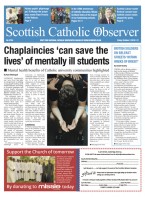October 5 | ![]() 0 COMMENTS
0 COMMENTS ![]() print
print

Let’s make Faith visible in our homes, by Fr Michael Kane
With Marian shrines, statues, and prayer we can reap the benefits of religious life beyond Sunday Mass
Last week was a great week to be a Michael as my namesake featured heavily in the life of the Church.
First we celebrated the Feast of the Archangels, in which St Michael is commemorated as the great defender of God in battle. Then later in the week we heard that the Holy Father was encouraging all the faithful to offer the daily prayer to St Michael, calling upon him to defend and protect Christ’s Body the Church. This is something we’ll be starting soon in St Augustine’s at the end of each Mass and I suspect it will now become a regular prayer in parishes up and down the country.
Pope Francis has also called for the Church to unite in reciting the Rosary each day during October, as a means of marking Our Lady’s month. In this way he invites us to welcome Mary to reign as Queen of our families and Queen of our homes.
Such pious practices occupy an honourable place in our Catholic tradition. They are a means of strengthening our Faith beyond the weekly observance of Sunday Mass. Keeping a daily Rosary, for example, or marking Fridays with a penitential fast or abstaining from meat, all contribute to deepening our Catholic identity; they continually connect us to the Lord and His Church at prayer.
I’m sure it would be fair to say that such noble traditions have, in recent times, found resonance, above all, among an older generation of Catholics. Fewer young people today will carry a Rosary, never mind put it to use. It is seen more as a novelty item or a jewellery piece, rather than a blessed article of religious devotion. Many young people struggle to appreciate the spiritual benefit of novenas, chaplets, or other traditional devotions. This is an unfortunate reality of today’s Church. There is an untapped source of grace in the spiritual lives of many Catholics today.
It’s no wonder that so many people, particularly the young, struggle to connect with the Church on Sundays, given that religion is often absent in their ordinary, everyday lives. When private, personal prayer is not part of our daily routine then our public, communal once-weekly worship loses its power too. Our presence at Mass at the weekend can become remote, disconnected and disjointed when it doesn’t flow from a personal spirituality and devotional life. Faith becomes an external thing to be done, rather than an interior way of life. Religion becomes something that happens for an hour on Sunday, without piercing the walls of our churches and seeping into our everyday lives.
This is why it is so important to heed the Holy Father’s words in this area. Past generations have shown that Faith is fed and nourished by a personal devotional life which enriches our relationship with God and the community of the Church.
Personal devotions retain an esteemed place in our tradition not least because they have graced the spiritual lives of countless Christians who have gone before us. Such practices drew our parents and grandparents closer to the Lord in the daily toil of life. For this reason they should not be so easily swept to the side.
In recent times we have tried in my own parish to encourage parishioners, young and not so young, to foster a personal devotional life. We are a broad Church; a diverse Catholic family and our devotions reflect this. Some in our parish keep the Angelus and daily Rosary faithfully, others the Divine Mercy Chaplet. Some are contemplative, others charismatic. Each of us in our own way is called to deepen and extend our love for the Lord through the gift of personal and sincere prayer. In my own life as a priest I have always found that when we pray more, we pray better. This is our intention.
By way of example, in our parish our Breakfast Club children have a custom of coming to the Church before school to say their morning prayers. Here they are invited to make their prayer intentions for that day, and to sing a hymn.
As you would expect, the children are desperate to be chosen to lead the prayers and hymn each morning. We get some unusual prayer intentions (lost teddies to be found and returned to their owners, sick pets et al) but importantly the children are learning to turn to God in prayer; they are learning to depend on Him.
Speaking of the merits of pious devotions, perhaps now is a good time to encourage other tangible Catholic practices. Setting-up a Marian altar in our homes and classrooms, and adorning them with fresh flowers, is a particularly beautiful custom during the Marian months of May and October.
Such simple practices convey our love and devotion for Our Lady who merits a very special place in our Faith. Very importantly, such gestures express Catholic culture to children and young people in a sort of visual theology.
In my own life these simple Catholic practices which I remember from my youth still evoke vibrant and warm memories. Surely these are noble practices which should be handed-on zealously to the next generation.
The crucifix, statues, holy water fonts, home blessings and other religious objects have a similar force in creating a much needed visual theology in our homes and schools. My heart sinks whenever I enter a Catholic home to be met at the front door with a buddha figure in place of a crucifix. It is unfortunate that so many Catholic homes have no visible sign of the Christian Faith. Perhaps we could add these woes to a growing list for St Michael the Archangel to sort out for us!











